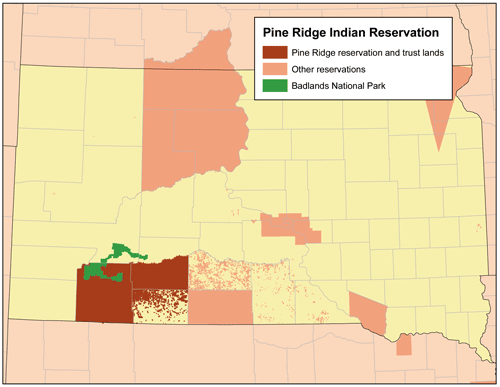 Wikipedia | 03-Sep-2014
Wikipedia | 03-Sep-2014
The Pine Ridge Indian Reservation (Wazí Aháŋhaŋ Oyáŋke in Lakota, also called Pine Ridge Agency) is an Oglala Lakota Native American reservation located in the U.S. state of South Dakota. Originally included within the territory of the Great Sioux Reservation, Pine Ridge was established in 1889 in the southwest corner of South Dakota on the Nebraska border. Today it consists of 3,468.85 sq mi (8,984.306 km2) of land area and is the eighth-largest reservation in the United States, larger than Delaware and Rhode Island combined.
The reservation encompasses the entirety of Shannon County, the southern half of Jackson County and the northwest portion of Bennett County. Of the 3,143 counties in the United States, these are among the poorest. Only 84,000 acres (340 km2) of land are suitable for agriculture. Extensive off-reservation trust lands are held mostly scattered throughout Bennett County (all of Bennett County was part of Pine Ridge until May 1910),[1][2] and also extend into adjacent Pine Ridge (Whiteclay), Nebraska in Sheridan County, just south of the community of Pine Ridge, South Dakota, the administrative center and largest community within the reservation. The 2000 census population of the reservation was 15,521; but a study conducted by Colorado State University and accepted by the United States Department of Housing and Urban Development has estimated the resident population to reach 28,787.[3]
Pine Ridge is the site of several events that marked tragic milestones in the history between the Sioux of the area and the United States (U.S.) government and its citizens. Stronghold Table—a mesa in what is today the Oglala-administered portion of Badlands National Park—was the location of the last of the Ghost Dances. The U.S. authorities’ attempt to repress this movement eventually led to the Wounded Knee Massacre on December 29, 1890. A mixed band of Miniconjou Lakota and Hunkpapa Sioux, led by Chief Spotted Elk, sought sanctuary at Pine Ridge after fleeing the Standing Rock Agency, where Sitting Bull had been killed during efforts to arrest him. The families were intercepted by a heavily armed detachment of the Seventh Cavalry, which attacked them, killing many women and children as well as warriors. This was the last large engagement between U.S. forces and Native Americans and marked the end of the western frontier.
Changes accumulated in the last quarter of the 20th century; in 1971 the Oglala Sioux Tribe (OST) started Oglala Lakota College, a tribal college, which offers 4-year degrees. In 1973 decades of discontent at the Pine Ridge Reservation resulted in a grassroots protest that escalated into the Wounded Knee Incident, gaining national attention. Members of the Oglala Lakota, the American Indian Movement, and supporters occupied the town in defiance of federal and state law enforcement in a protest that turned into an armed standoff lasting 71 days. This event inspired American Indians across the country and gradually led to changes at the reservation, with a revival of some cultural traditions. In 1981 the Lakota Tim Giago started the Lakota Times at Pine Ridge, the first independent Native American newspaper in the nation, which he published until selling it in 1998.
At the southern end of the Badlands, the reservation is part of the mixed grass prairie, an ecological transition zone between the short-grass and tall-grass prairies; all are part of the Great Plains. A great variety of plant and animal life flourishes on and adjacent to the reservation, including the endangered black-footed ferret. The area is also important in the field of paleontology; it contains deposits of Pierre Shale formed on the seafloor of the Western Interior Seaway, evidence of the marine Cretaceous–Paleogene boundary, and one of the largest deposits of fossils of extinct mammals from the Oligocene epoch.
Get the full article here: http://en.wikipedia.org/wiki/Pine_Ridge_Indian_Reservation
